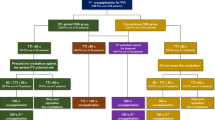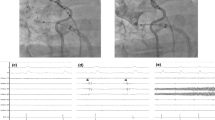Abstract
Background
Validation of pulmonary vein (PV) isolation (PVI) using only the Achieve catheter following cryoballoon ablation (CBA) is imperfect since pulmonary vein potentials (PVP) can be recorded in only 50–85% of the veins and residual PVP are found in up to 4.3–7.6% of the isolated veins in remapping studies.
Objective
To study if addition of electroanatomical mapping to Achieve catheter–guided CBA is superior for PVI.
Methods
One hundred patients were randomized between Achieve catheter–guided CBA (control group; N = 50) and Achieve catheter–guided CBA with additional EnSite voltage maps performed pre- and post-CBA (Achieve Plus group; N = 50). Confirmation of PVI was done by circular mapping catheter (CMC) and EnSite mapping by a second blinded operator.
Results
Despite apparent PVI in all PVs after CBA, incomplete PVI was present in 0 out of 50 patients (0%) and 0 out of 204 PVs in the Achieve Plus group versus 6 patients out of 50 (12%; P = 0.012) and 6 out of 203 PVs (3%; P = 0.013) in the control group. All 6 non-isolated PVs could be successfully isolated by additional cryoapplications. Procedure time was longer in the Achieve Plus group (75.76 ± 21.65 vs 66.06 ± 16.83 min; P = 0.014) with equal fluoroscopy times (14.85 ± 6.41 vs 14.33 ± 8.55; P = 0.732).
Conclusion
The addition of electroanatomical EnSite mapping to the Achieve catheter improves the PVI rate of CBA and could be considered for future use.
Graphical abstract
Design and Results of the Achieve Plus study. The Achieve Plus study shows that the addition of electro-anatomical EnSite mapping to the Achieve catheter improves PVI rate of CBA and could be considered for future use. See text for further explanation. Abbreviations: CBA: cryoballoon ablation; PVI: pulmonary vein isolation.




Similar content being viewed by others
Data and/or Code availability
The authors confirm that the data supporting the findings of this study are available within the article. The study data are available from the corresponding author, YDG, upon reasonable request.
References
Neumann T, Wojcik M, Berkowitsch A, Erkapic D, Zaltsberg S, Greiss H, et al. Cryoballoon ablation of paroxysmal atrial fibrillation: 5-year outcome after single procedure and predictors of success. Europace. 2013;15:1143–9.
Kuck KH, Brugada J, Furnkranz A, Metzner A, Ouyang F, Chun KR, et al. FIRE AND ICE Investigators. Cryoballoon or radiofrequency ablation for paroxysmal atrial fibrillation. N Engl J Med. 2016;374:2235–45.
Heeger CH, Wissner E, Knoll M, Knoop B, Reissmann B, Mathew S, et al. Three year clinical outcome after 2nd-generation cryoballoon-based pulmonary vein isolation for the treatment of paroxysmal and persistent atrial fibrillation - a 2-center experience. Circ J. 2017;81:974–80.
Chierchia GB, Di Giovanni G, Ciconte G, de Asmundis C, Conte G, Siera-Moret J, et al. Second-generation cryoballoon ablation for paroxysmal atrial fibrillation: 1-year follow-up. Europace. 2014;16:639–44.
Furnkranz A, Bordignon S, Schmidt B, Gunawardene M, Schulte-Hahn B, Urban V, et al. Improved procedural efficacy of pulmonary vein isolation using the novel second-generation cryoballoon. J Cardiovasc Electrophysiol. 2013;24:492–7.
Boveda S, Providência R, Albenque JP, Combes N, Combes S, Hireche H, et al. Real-time assessment of pulmonary vein disconnection during cryoablation of atrial fibrillation: can it be ‘achieved’ in almost all cases? Europace. 2014;16:826–33.
Yokoyama K, Tokuda M, Matsuo S, Isogai R, Tokutake K, Kato M, et al. Pulmonary vein remapping after cryoballoon ablation for atrial fibrillation. Europace. 2018;20:943–8.
Conte G, Soejima K, de Asmundis C, Chierchia GB, Badini M, Miwa Y, et al. Value of high-resolution mapping in optimizing cryoballoon ablation of atrial fibrillation. Int J Cardiol. 2018;270:136–42.
Meissner A, Maagh P, Christoph A, Oernek A, Plehn G. Pulmonary vein potential mapping in atrial fibrillation with high density and standard spiral (lasso) catheters: A comparative study. J Arrhythm. 2017;33:192–200.
Stroker E, De Greef Y, Schwagten B, Kupics K, Coutino HE, Takarada K, et al. Over-the-needle trans-septal access 16 using the cryoballoon delivery sheath and dilator in atrial fibrillation ablation. PACE. 2019;42:868–73.
De Greef Y, Schwagten B, Chierchia GB, de Asmundis C, Stockman D, Buysschaert I. Diagnosis-to-ablation time as a predictor of success: early choice for pulmonary vein isolation and long-term outcome in atrial fibrilllation: results from the Middelheim-PVI Registry. Europace. 2018;20:589–95.
Guhl E, Adelstein E, Voigt A, Wang NC, Saba S, Jain SK. Impact of 3D mapping on procedural characteristics and outcomes in cryoballoon pulmonary vein isolation for atrial fibrillation. J Interv Card Electrophysiol. 2018;51:71–5.
Author information
Authors and Affiliations
Contributions
All authors contributed to the study conception and design. Material preparation, data collection, and analysis were performed by Y. De Greef, M. Tijskens, I. Buysschaert, and J. P. Abugattas de Torres. The first draft of the manuscript was written by Y. De Greef and all authors commented on previous versions of the manuscript. All authors read and approved the final manuscript.
Corresponding author
Ethics declarations
Ethics approval
This study was performed in line with the principles of the Declaration of Helsinki. Approval was granted by the Medical Ethics Committee ZNA, Institutional Review Board-ZNA/OCMW Antwerp, Lindendreef 1, 2020 Antwerp (E.C. Approval No. 5482).
Consent to participate and/or consent for publication
Written informed consent was obtained from all individual participants included in the study.
Competing interests
The authors declare no competing interests.
Additional information
Publisher’s note
Springer Nature remains neutral with regard to jurisdictional claims in published maps and institutional affiliations.
Rights and permissions
Springer Nature or its licensor holds exclusive rights to this article under a publishing agreement with the author(s) or other rightsholder(s); author self-archiving of the accepted manuscript version of this article is solely governed by the terms of such publishing agreement and applicable law.
About this article
Cite this article
De Greef, Y., Tijskens, M., De Torres, J.P.A. et al. Electroanatomical mapping improves procedural outcomes of cryoballoon pulmonary vein isolation (the Achieve Plus study). J Interv Card Electrophysiol 66, 923–930 (2023). https://doi.org/10.1007/s10840-022-01384-w
Received:
Accepted:
Published:
Issue Date:
DOI: https://doi.org/10.1007/s10840-022-01384-w




